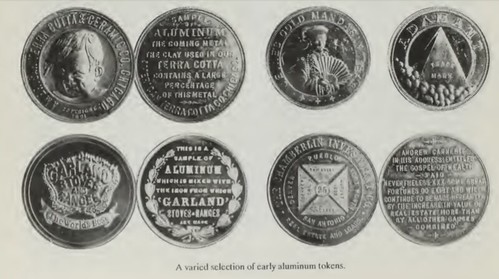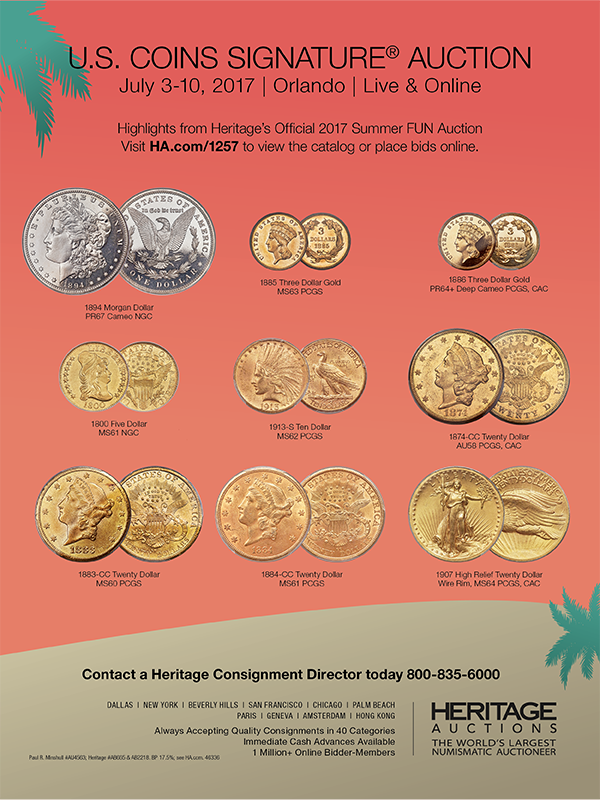
PREV ARTICLE
NEXT ARTICLE
FULL ISSUE
PREV FULL ISSUE
ALUMINUM USE IN TOKENS AND MEDALSDavid Schenkman writes: The article on aluminum was interesting, but factually inaccurate. In 1880 aluminum was still $8 a pound; way too high to be used to strike tokens and medals. It wasn't until Charles Hall invented his Hall process of reducing aluminum by electrolysis in 1886 that it started coming down. It wasn't until the very late 1880s that numismatic items started to appear. Incidentally, I believe the earliest US Mint product in aluminum was a unique striking of a 1855 half dollar. Many years ago I wrote a rather lengthy article on the numismatics of aluminum, which was in the TAMS Journal.
This is in reference to Dick Johnson's Vocabulary item a couple weeks ago - I ran out of time to get this in last week's issue.
Dave offered to send me the text of his TAMS Journal piece, but I thought I'd try the Newman Numismatic Portal first. I found the article in seconds -
Vol. 30, No. 6, December 1990. Of course, I had to use an appropriately specific search string - "aluminum" alone would return thousands of hits.
Including Dave's name in the search brought the article back near the bottom my my first page of results. Here's an excerpt from the article.
-Editor

Aluminum, that wonderful new metal! Eulogized on medals of the early 1890s as malleable, tasteless, sonorous, ductile, untarnishable, odorless, and one-quarter the weight of silver, it is no wonder that this “discovery” would capture the fancy of a nation. However, as we shall see, aluminum was hardly a newly discovered metal in the last decade of the nineteenth century. In this article we will review nineteenth and early twentieth century efforts to manufacture aluminum, trace the early history of a company whose growth is intertwined inseparably with the metal, and discuss the early usage of aluminum in numismatics. The first significant attempt to isolate aluminum from alumina (aluminum oxide) was by an English electrochemist. Sir Humphrey Davy, in 1807. Convinced that alumina had a metallic base, he named the metal alumium, later revising the word to aluminum. This name has remained unchanged to the present time, although the English spelling is usually aluminium. In Philadelphia, at Col. William Frishmuth’s chemical works, a 100 ounce aluminum pyramid was cast in 1884. After being placed on exhibit at the Fifth Avenue showroom of Tiffany’s in New York City, it was mounted on the top of the Washington Monument. This was undoubtedly the best known usage of aluminum prior to the Hall process. The pyramid, incidently, was removed for inspection fifty years later; it had remained in good condition, and after a thorough cleaning the inscriptions could still be read. No longer was the problem how to manufacture the metal — now what was needed was a method for producing it inexpensively. At $17 an ounce (in 1854) it was worth nearly its weight in gold. In 1886 the price of $8 a pound still made it prohibitive for use in industry. Since sodium, the key element in the process, was the most costly item (and nearly three pounds were needed to produce one pound of aluminum), most research during this period was directed towards finding less expensive methods for its extraction. It remained for a twenty-two year old inventor, working in a makeshift laboratory, to discover that which had eluded scientists for years. Charles Martin Hall was truly one of the giants of American industrial history. Born 6 December 1863 at Thompson, Ohio, he was the son of a minister. When he was nine years of age his family moved to Oberlin, Ohio, where young Charles developed an absorbing interest in chemistry. In 1880 Charles enrolled in Oberlin College, a liberal arts school. He took those chemistry courses which were offered, supplementing his interest by studying at home. Frank F. Jewett, his chemistry professor, recalled that even when in high school, Charles would visit the college laboratory to purchase equipment for his experiments. On one occasion he confided to the professor that he was experimenting with ways to produce aluminum from its ores.
To read the complete article on the Newman Portal, see:
To read the earlier E-Sylum article, see:

Wayne Homren, Editor The Numismatic Bibliomania Society is a non-profit organization promoting numismatic literature. See our web site at coinbooks.org. To submit items for publication in The E-Sylum, write to the Editor at this address: whomren@gmail.com To subscribe go to: https://my.binhost.com/lists/listinfo/esylum All Rights Reserved. NBS Home Page Contact the NBS webmaster 
|